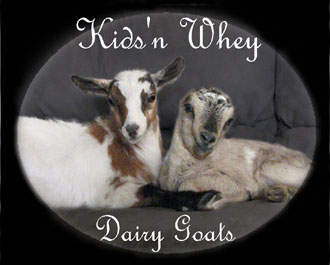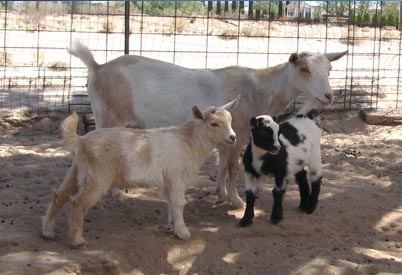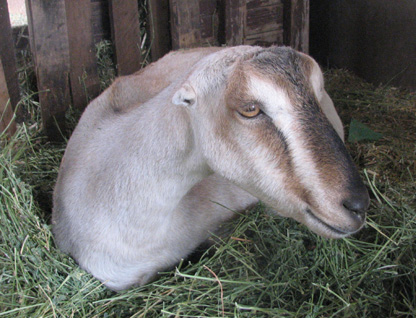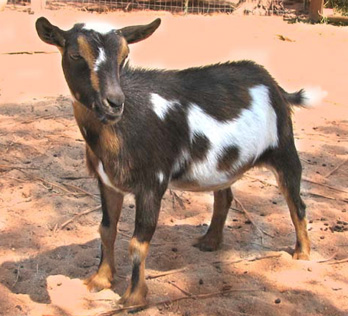Chekia lovingly presents ....
A little history
Thus it is well documented that goats have been supplying the world with the most healthful milk on the planet for literally centuries. RAW goat milk is known to be nutrient rich, easily digestible, and well tolerated even by individuals "lactose intolerant" of cow milk. It contains digestive aids known as oligosaccharides which act as a prebiotic in the intestine, feeding the healthy bacteria and suppressing the bad. Additionally, these prebiotics have anti inflammatory properties which, among other healthful benefits, are useful in addressing irritable bowel disease. Some studies have even determined that the minerals found in goat milk are far better absorbed and utilized by the body than the same minerals contained in cow milk. Thus nutritional deficiencies such as anemia and bone demineralization respond positively to the addition of RAW goat milk to the diet.
Beyond all this, RAW goat milk has been found to be effective in stimulating the release of nitric oxide in vitro, as well as supplying a good source of medium-chain fatty acids. These qualities are important in both warding off and treating heart disease as well as high blood pressure, as they act to keep arteries working properly, and triglyceride and cholesterol levels in check. It is no wonder the Journal of the American Medical Association has called RAW goat milk the most complete and nutritious food on the planet.
The LaMancha goat is a breed best known by the general public for it's tiny ears and friendly personality. To the true dairy goat enthusiast, however, there is much history and even greater value behind those telltale markers. For hundreds of years, the occurrence of tiny eared goats has been noted in both wild and dairy herds throughout the world. Generally they were casually considered "sports" and much attention was never paid to them.
That all changed forever, though, when a dairy goat breeder in Southern California, U.S., took a particular liking the the tiny eared sports, and decided to pursue creating a breed based on their attributes.
The woman was Eula Fey Frey and the year was 1938. Ms Frey had been inspired by the fact that tiny eared goats from Spain had first been exhibited at the Paris Goat Show in 1903.
"Mama, Where do little kids come from?"
Breeding a Nubian / Alpine buck to a tiny eared doe of undocumented parentage, Ms Frey produced a large eyed brown doe she named Peggy, and from that foundation, the LaMancha breed was born. Alpines, Toggenburgs, French Alpines and Nubians all figured in the the early establishment of the breed, and the selection of offspring was consistently based on the best dairy qualities of the individuals. It didn't take long for Ms Frey to discover that those qualities typically accompanied the tiny ears which had always intrigued her. High milk production, sweet milk taste, and a gentle, easy going nature in the goats themselves also typically came along with the tiny eared quality.
Today our "made in America" California LaMancha is well represented throughout the country in goat shows and dairy barns as well as in back yards where pet goats are loved and cherished. They are recognized as a purebred dairy breed by the American Dairy Goat Association and other goat registries as well.
Domestic goats have been with us since earliest recorded civilization. The Bible book of Genesis tells of the goat herds owned by the prophet Abraham and others. Later, in Proverbs, it specifically addresses their dairy qualities in stating; "And there is a sufficiency of goats’ milk for your food, for the food of your household, and the means of life for your girls." (Proverbs 27:27)
Goats are able to thrive in a variety of climates and geographical locations including arid, semitropical and mountainous regions. Being browsers rather than grazers, they select the most nutritious parts of the plants they encounter and can utilize a wide range of forage on which other livestock animals would typically starve. Add to this the superior quality and digestibility of their milk, and it becomes easy to understand why throughout history and throughout the world, (and even today) more people consume dairy products from goats than from any other animal.
Dairy Goats
LaMancha Dairy Goats
Nigerian Dwarf Dairy Goats
The history of this plucky little breed is somewhat sketchy. In the early twentyith century, Dr. Albert Schweitzer wrote about a small West African goat able to tolerate the dreaded tse tse fly. This goat was locally referred to as simply the West African Dairy Goat or WAD. These goats supplied milk for the hospital where Dr. Schweitzer did his work in the country known today as Gabone. Photos of the WAD show an animal very much similar to what we now call in the United States the Nigerian Dwarf.
While we know that WAD goats had been imported to the United States as early as 1918, documented importations from the 1930's to the 1960's are known to have resulted in the breed's becoming established as a zoo exhibit. It was not until the 1980's that goat breeders began to take this little goat seriously as a genuinely dairy style milk producer.
Working at the time in a California zoo, Mrs. Bonnie Abrahamson of North Ogden, Utah took an interest in the WAD, which at that time had been lumped in with other small goats under the general label of "Pygmy Goat". Noting a definite difference in what eventually became known as the Pygmy breed and dairy style WAD, she set out to have them recognized as a true dairy breed. Around that same time, Mrs. Herbert Woods of Alexandria, Indiana was making similar discernments. Together the two women petitioned the International Dairy Goat Registry (IDGR) to open a herdbook for what they decided to call Nigerian Dwarves. By July of 1981, a buck bred by Mrs. Abrahamson by the name of Bullfrog Alleys Johnny Jump-Up #2 became the first Nigerian Dwarf registered by any registry. His owner was
Mr. Robert Johnson.
Because of their small size, sweet nature, and ability to supply a good quart of milk or more on a daily basis, the little Nigerian became instantly popular with people on suburban plots and limited incomes. With many thousands of representatives being raised and shown today, they are often the most popular breed in exhibition at goat shows and 4H shows throughout the United States. As well, their popularity has spawned the foundation of miniaturized versions of the other dairy goat breeds. Crossing the long established breeds with Nigerians to create "mini" types now being registered as separate breeds has become the hobby interest of a number of dairy goat breeders anxious to have small versions of their own chosen varieties.
Nonetheless, the Nigerian Dwarf has maintained a fan base of staunch supporters who love and admire them in their own right, and for their own dairy character, smart, sweet nature, and extensive variety in beauty. Additionally, they are highly prized for the sweet "cotton candy" taste of the milk they produce. They are now recognized as a purebred dairy breed by The American Dairy Goat Association, and other goat registries as well.
A Little History, A Little Science
by Terry Thistlethwaite
You're listening to
Sentimental Journey
by Les Brown, Ben Homer & Bud Green



